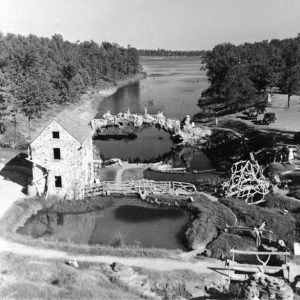calsfoundation@cals.org
Old Mill
Famous for its appearance in the opening credits of the 1939 classic movie Gone with the Wind, the Old Mill in the five-acre T. R. Pugh Memorial Park in North Little Rock (Pulaski County) contains the work of noted Mexican sculptor Dionicio Rodriguez, who perfected the folk art style known as faux bois (fake wood) by crafting reinforced concrete to resemble petrified logs. Justin Matthews, the developer of the town’s Park Hill and Lakewood subdivisions, hired Rodriguez in 1932 to create a tourist attraction for his new suburban development. Formally named Pugh’s Mill in honor of Matthews’s lifelong friend Thomas R. Pugh, the mill features a two-story stone building, bridges, benches, and other examples of Rodriguez’s art, all designed to look like an abandoned nineteenth-century gristmill.
Matthews started the first suburban development in North Little Rock in 1921 on a hill north of the city limits that he called Park Hill. This first phase was highly successful, and by the late 1920s, he had opened more streets and lots east of Park Hill and was constructing six recreational lakes for Lakewood. He chose the site for the park because of its rough and unsightly terrain. Justin Matthews Company architect Frank Carmean drew the plans for the mill, which was dedicated on August 6, 1933.
At the ceremony with Matthews and Rodriguez were Governor Charles H. Brough, former mayor Ross Lawhon, and Pugh’s five-year-old granddaughter, Jane Anne Pugh, who pulled a ribbon to release the water above the wheel and start its operation. According to newspaper reports, Rodriguez spoke briefly through an interpreter to say that he considered the work his greatest commission ever in the United States. He said he used only the finest grade of cement and the best structural steel and copper so the creations would “live in the sight of any who may live or visit in this community for centuries.” Addressing the crowd, Matthews praised the sculptor’s mechanical skill, his intimate knowledge of nature, his ability to remember details, and his conception of color. Brough credited Matthews for securing the services of Rodriguez, who, he said, “has perpetuated in concrete entrancingly beautiful pieces of work.” Music was performed by the Dixie Quartet, which sang “I Want to Dream by the Old Mill Stream,” “Down by the Old Mill Stream,” and “There’s an Old Mill Stream.”
An advertisement a week later in the Arkansas Gazette touted the Old Mill’s rustic charm, claiming Rip Van Winkle “would feel at home in Pugh’s Mill Park.” Designed to appear as abandoned and forgotten by the hurrying world around it, quietly weathering the years in the hollow of a secluded little valley, the old gristmill and driving equipment are disconnected from the water wheel. The water gate on the flume above the wheel, although closed, leaks enough water to keep the wheel turning.
The two-story, rock mill building is fitted with a five-ton water wheel made by Rodriguez. In the building are remnants of a working mill that has been neglected for years. The floor and stairs have the look of well-worn wood planks, and the hand railings seem to be logs and limbs nailed together. But some things in the mill are what they appear to be. The iron gristmill on the first floor was from a working mill for many years and dates to 1828 from the Cagle family in Pope County. Several millstones, as well as some iron pieces from the shaft of a steamboat that once cruised the Arkansas River, are in the building. Two stones on the north end of the park with numbers “1” and “4” chiseled in their surfaces are original milestones from a road laid out along the Arkansas River near Dardanelle (Yell County) by Jefferson Davis, who was then a young army engineer. Along this road, the Cherokee and Choctaw Indians traveled on the Trail of Tears into Indian Territory, now Oklahoma.
The former Justin Matthews Company gave the park to the city on May 24, 1976. In 1990, the Old Mill was the site of the unveiling of a postage stamp commemorating the fiftieth anniversary of Gone with the Wind’s receiving eight Academy Awards. (No one knows how the Old Mill was chosen for that opening shot.)
The wooden roof was damaged by probable arson on December 16, 2008. In 2019, the city added a cascading waterfall to turn the wheel of the mill. The mill attracts thousands of visitors a year.
For additional information:
Crawford, Sybil F. “Dionicio Rodriguez: The Faux Bois Sculptor.” Pulaski County Historical Review 50 (Spring 2002): 13–24.
Horn, Deborah. “The Old Mill.” The Leader, June 12, 2019, p. 11A.
Kazas, Tom. “Looks Like Wood.” Americana 16 (September–October 1989): 54–58.
Sandlin, Jake. “Flow to Turn Wheel, Add to Charm at NLR Site.” Arkansas Democrat-Gazette, July 6, 2019, pp. 1A, 3A.
———. “Old Mill Waterfall Strikes a Chord.” Arkansas Democrat-Gazette, September 19, 2019, pp. 1B, 7B.
Sandra Taylor Smith
North Little Rock History Commission
 Old Mill
Old Mill  Old Mill Visitors
Old Mill Visitors  Old Mill
Old Mill 




Comments
No comments on this entry yet.